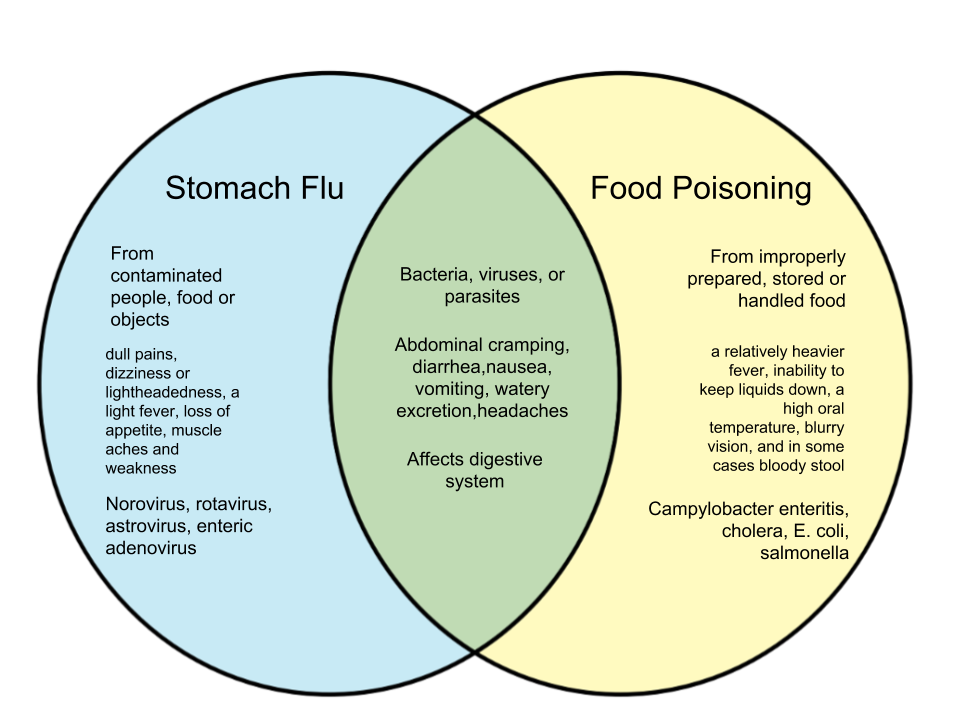Difference between Food Poisoning and Stomach Flu
A loved one is complaining about abdominal cramping, diarrhea, and nausea. There are many possible reasons. These same symptoms apply to a variety of illnesses, including food poisoning and stomach flu. There are many who tend to self-diagnose and follow their own beliefs in treating the symptoms, but approaching it wrongly may prove fatal. Here are some differences that can help distinguish between food poisoning and stomach flu, to help mitigate the ailments before heading for medical assistance.
Both food poisoning and stomach flu can be identified through symptoms like those stated above, as well as vomiting, watery excretion, and headaches. However, they also have symptoms unique to each ailment. A stomach flu, also known as a stomach virus or viral gastroenteritis, is known to possess symptoms like dizziness or lightheadedness, a light fever, loss of appetite, muscle aches and weakness. Aches in stomach flu tend to be dull as opposed to food poisoning. On the other hand, food poisoning exhibits a relatively heavier fever, inability to keep liquids down, a high oral temperature, blurry vision, or even bloody stools.
Stomach flu can be caused by viral infections attacking the digestive system, and has several strains. It is highly contagious and spreads rapidly. Consuming contaminated food or drinks and having direct/indirect mouth contact with an affected person or object can cause transmission of the virus. This illness possesses an incubation period of one to two days following exposure to the virus. Effects can linger for two to three days. Diagnosis and treatment varies with the strain and symptoms.
Food poisoning happens when one consumes improperly prepared, stored or handled food. Bacteria, viruses, and parasites are the direct causes of the sickness. Symptoms may show up suddenly weeks after eating contaminated food. Food poisoning can have more severe complications especially for those with a weaker immune system. This sickness has a quicker rebound rate than stomach flu.
It is important to be able to identify the right sickness to treat it more effectively. However, the best way to handle an ailment is to seek medical attention to get the best diagnosis and treatment before it gets worse.
| Stomach Flu | Food Poisoning | |
|---|---|---|
| Definition | A short-lived disorder caused by a bacteria,virus or parasite that affects the digestive system. | An ailment caused by bacteria or toxins in improperly handled food. |
| Causes | Bacteria, viruses, or parasites from contamination by infected people, consumables, or objects | Bacteria, viruses, or parasites from mishandled food and drinks. |
| Symptoms | Abdominal cramping, diarrhea,nausea, vomiting, watery excretion,headaches, dull pains, dizziness or lightheadedness, a light fever, loss of appetite, muscle aches and weakness | Abdominal cramping, diarrhea,nausea, vomiting, watery excretion,headaches, a relatively heavier fever, inability to keep liquids down, a high oral temperature, blurry vision, and in some cases bloody stool. |
| Transmission | Consuming contaminated food or drinks; having direct/indirect mouth contact with an affected person or object. | Consuming improperly prepared, stored or handled food. |
| Duration | Usually 1-3 days. | Usually 1-2 days. |
| Diagnosis and Treatment | ExampleDependent on strain, may need stool tests | Diagnosis is based on a detailed history of symptoms, duration, and food consumed, may need blood or stool test; treatment depends on source of poisoning and severity of symptoms. |
| Strains/Forms | Norovirus, rotavirus, astrovirus, enteric adenovirus | Campylobacter enteritis, cholera, E. coli, salmonella. |

